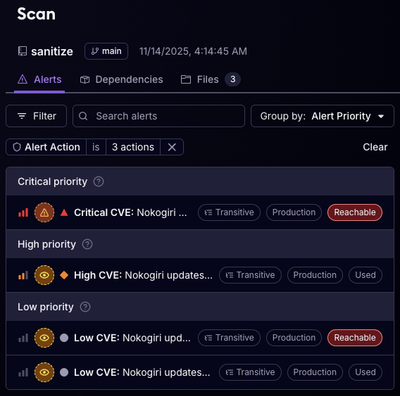
Product
Reachability for Ruby Now in Beta
Reachability analysis for Ruby is now in beta, helping teams identify which vulnerabilities are truly exploitable in their applications.
react-native-sticky-range-slider
Advanced tools
[React Native | TypeScript] A pure TypeScript component offering a customizable range slider optimized for performance. It supports dragging functionalities for selecting a range of values, with values that smoothly follow the thumb. This component is ful
A pure TS component offering a customizable range slider optimized for performance.
It supports dragging functionalities for selecting a range of values, with values that smoothly follow the thumb.
This component is fully compatible with both Android and iOS platforms.
Primarily forked from rn-range-slider.
npm install react-native-sticky-range-slider
yarn add react-native-sticky-range-slider
import React, { useCallback, useState } from "react";
import { Button, StyleSheet, Text, View } from "react-native";
import RangeSlider from "react-native-sticky-range-slider";
const MIN_AGE = 18;
const MAX_AGE = 60;
const Thumb = (type: "high" | "low") => (
<View
style={[styles.thumb, { backgroundColor: type === "high" ? "lime" : "purple" }]}
/>
);
const Rail = () => <View style={styles.rail} />;
const RailSelected = () => <View style={styles.railSelected} />;
const App = () => {
const [min, setMin] = useState(MIN_AGE);
const [max, setMax] = useState(MAX_AGE);
const [disableRange, setDisableRange] = useState(false);
const handleValueChange = useCallback((newLow: number, newHigh: number) => {
setMin(newLow);
setMax(newHigh);
}, []);
const handleToggle = () => {
setDisableRange((prev) => !prev);
};
return (
<View style={styles.container}>
<Text style={styles.title}>{disableRange ? "Set your age" : "Set Age Range"}</Text>
<RangeSlider
style={styles.slider}
min={MIN_AGE}
max={MAX_AGE}
step={1}
minRange={5}
low={min}
high={max}
onValueChanged={handleValueChange}
renderLowValue={(value) => <Text style={styles.valueText}>{value}</Text>}
renderHighValue={(value) => (
<Text style={styles.valueText}>{value === MAX_AGE ? `+${value}` : value}</Text>
)}
renderThumb={Thumb}
renderRail={Rail}
renderRailSelected={RailSelected}
disableRange={disableRange}
/>
<Button
onPress={handleToggle}
title={disableRange ? "Switch to double control" : "Switch to single control"}
/>
</View>
);
};
const THUMB_RADIUS = 10;
const styles = StyleSheet.create({
container: {
flex: 1,
justifyContent: "center",
padding: 20,
},
title: {
fontSize: 24,
textAlign: "center",
marginBottom: 20,
},
slider: {
marginVertical: 20,
},
valueText: {
color: "black",
},
thumb: {
width: THUMB_RADIUS * 2,
height: THUMB_RADIUS * 2,
borderRadius: THUMB_RADIUS,
borderWidth: 3,
borderColor: "black",
backgroundColor: "red",
},
rail: {
flex: 1,
height: 3,
borderRadius: 3,
backgroundColor: "grey",
},
railSelected: {
height: 3,
backgroundColor: "red",
},
});
export default App;
| Name | Description | Type | Default Value |
|---|---|---|---|
min | Minimum value for the slider. | number | required |
max | Maximum value for the slider. | number | required |
minRange | Minimum range between the low and high values. It is set to 0 if disableRange is true. | number | 0 |
step | Step value for the slider. | number | required |
low | Low value for the slider. | number | required |
high | High value for the slider. | number | required |
onValueChanged | Callback function that gets called when the slider values change. Receives the new low and high values as arguments. | (low: number, high: number) => void | required |
renderThumb | Function to render the thumb component. Accepts a type parameter which can be either high or low. | (type: 'high' or 'low') => React.ReactNode | Default Thumb |
renderRail | Function to render the rail component. | () => React.ReactNode | Default Rail |
renderRailSelected | Function to render the selected rail component. | () => React.ReactNode | Default RailSelected |
renderLowValue | Function to render the component displaying the low value. Receives the low value as an argument. | (low: number) => React.ReactNode | Default LowValueText |
renderHighValue | Function to render the component displaying the high value. Receives the high value as an argument. | (high: number) => React.ReactNode | Default HighValueText |
pannableAreaStyle | Style for the pannable area. | StyleProp<ViewStyle> | Default Pannable Area Style |
disableRange | When set to true, the slider functions as a standard slider with a single control. | boolean | false |
disabled | User interactions will be ignored when set to true. | boolean | false |
Contributions are welcome! If you have any suggestions, feature requests, or bug reports, feel free to open an issue or submit a pull request. Let's make this component even better together! 😃
MIT
Made with create-react-native-library
FAQs
[React Native | TypeScript] A pure TypeScript component offering a customizable range slider optimized for performance. It supports dragging functionalities for selecting a range of values, with values that smoothly follow the thumb. This component is ful
We found that react-native-sticky-range-slider demonstrated a healthy version release cadence and project activity because the last version was released less than a year ago. It has 0 open source maintainers collaborating on the project.
Did you know?

Socket for GitHub automatically highlights issues in each pull request and monitors the health of all your open source dependencies. Discover the contents of your packages and block harmful activity before you install or update your dependencies.

Product
Reachability analysis for Ruby is now in beta, helping teams identify which vulnerabilities are truly exploitable in their applications.

Research
/Security News
Malicious npm packages use Adspect cloaking and fake CAPTCHAs to fingerprint visitors and redirect victims to crypto-themed scam sites.

Security News
Recent coverage mislabels the latest TEA protocol spam as a worm. Here’s what’s actually happening.